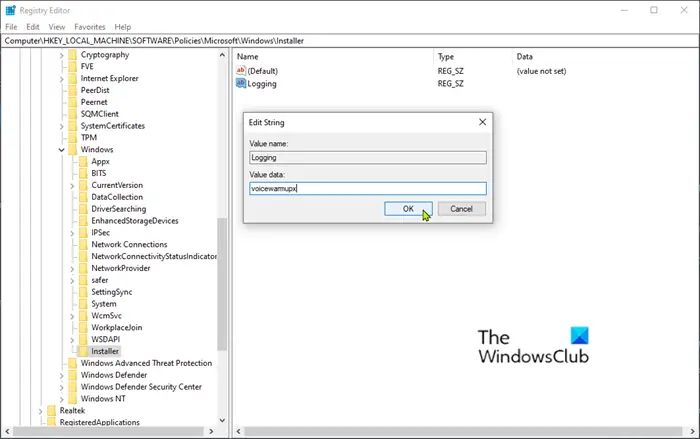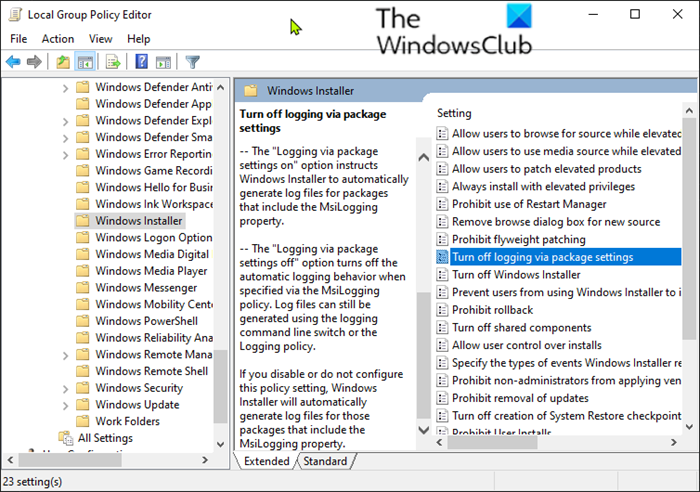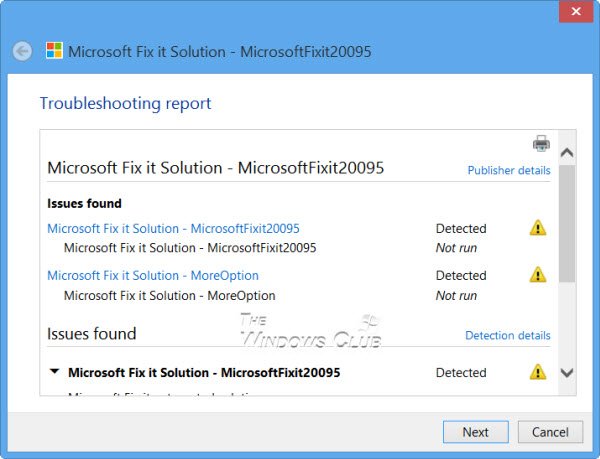Windows includes a Registry-activated logging service to help diagnose Windows Installer issues. In today’s post, we will describe the steps on how to enable this Windows Installer logging service on Windows 11/10. Windows Installer is the standard Microsoft technology for deploying applications. It offers a format for packaging an application and an engine to unpack and install an application. MSI packages are used instead of proprietary installation systems, allowing your installer to run on any Windows platform from Windows 95 to Windows 11/10.
The Windows Installer, also known as Microsoft Installer, is a software component of the Windows operating system, that is used for the installation, maintenance, and removal of software. Sometimes installations fail because the Windows Installer is not able to do its job. Such Windows Installer issues can typically be caused by data corruption, corrupt installations, and so on. While Windows may roll back the installation, the issue would remain unresolved.
In case you face problems while installing programs on your Windows machine, you can refer to the logs which are maintained by Windows Installer. But for that, you have to enable logging first. After you have enabled Microsoft Installer logging, you can try to install the application again. Windows Installer will then track the progress and record all the data in a log file. These log files and events can help you troubleshoot installation issues and you can even share them with support professionals.
Verbose logging records more information in the logs generated by the Microsoft Installer. It tracks all changes and settings applied using Group Policy and its extension to the local computer and to users who log on to the computer. They are usually enabled if you need additional data. Such log files are usually found in C:\Debug and are typically large in size.
Windows Installer can use logging to help assist in troubleshooting issues with installing software packages. This logging is enabled by adding keys and values to the registry. After the entries have been added and enabled, you can retry the problem installation and Windows Installer will track the progress and post it to the Temp folder. The new log’s file name is random. However, the first letters are “Msi” and the file name has a “.log: extension. To locate the Temp folder, type the following line at a command prompt:
cd %temp%
When you enable Microsoft Installer logging, the error codes generated by Windows Installer are captured and stored in the log files. You can also contact Microsoft Support and pass on the error codes or log files to them.
These Windows Installer log names start with ‘msi’, followed by a bunch of alphanumeric characters, and are saved in the .log file format. They are normally stored in the following location, which is hidden:
C:\Documents and Settings\UserName\Local Settings\Temp\
Once you are done, you may disable Microsoft Installer logging
Enable Windows Installer logging on Windows 11/10
You can enable Windows Installer logging and Verbose logging manually, using any of these methods:
- Via Registry Editor
- Via Local Group Policy Editor
- Use Microsoft Fix-It
Now let’s take a look at both the procedures.
1] Enable Windows Installer logging via Registry Editor

Since this is a registry operation, it’s recommended you back up the registry or create a system restore point as a precautionary measure in case the procedure goes wrong.
Once you have done any of the above actions, you can now proceed as follows.
- Launch Registry Editor (press Windows key and type regedit, then hit Enter).
- Navigate to the following registry key:
HKEY_LOCAL_MACHINE\Software\Policies\Microsoft\Windows\Installer
If you don’t see a Installer key (folder) below the Windows folder, right-click the Windows folder and select New > Key. Name it Installer.
You can then create the following subkey and keys:
Type: Reg_SZ
Value: Logging
Data: voicewarmupx
Right-click the Installer key (folder) in the left pane and select New > String Value.
Name the value Logging.
Double-click the entry to edit it’s properties and set the Value data as voicewarmupx.
The letters in the value field can be in any order. Each letter turns on a different logging mode. Each letter’s actual function is as follows for MSI version 1.1:
- v – Verbose output
- o – Out-of-disk-space messages
- i – Status messages
- c – Initial UI parameters
- e – All error messages
- w – Non-fatal warnings
- a – Start up of actions
- r – Action-specific records
- m – Out-of-memory or fatal exit information
- u – User requests
- p – Terminal properties
- + – Append to existing file
- ! – Flush each line to the log
- x – Extra debugging information. The “x” flag is available only on Windows Server 2003 and later operating systems, and on the MSI redistributable version 3.0, and on later versions of the MSI redistributable.
- “*” – Wildcard: Log all information except the v and the x option. To include the v and the x option, specify “/l*vx”.
Click OK.
You can now exit Registry Editor and restart PC for changes to take effect.
Note: This change should be used only for troubleshooting and should not be left on because it will have adverse effects on system performance and disk space. Each time that you use the Add or Remove Programs item in Control Panel, a new Msi*.log file is created. To disable the logging, remove the Logging registry value.
Read: Enable Verbose or Highly Detailed Status Messages,
2] Enable Windows Installer logging via Group Policy Editor

To enable Windows Installer logging on Windows 10 using Local Group Policy Editor (gpedit.msc), do the following;
- Launch the Local Group Policy Editor.
- Navigate to the following setting:
- Computer Configuration > Administrative Templates > Windows Components > Windows Installer
- Locate the Logging setting in the right pane and double-click on it to edit its properties.
- Click Enabled.
- In the Logging box, enter the options you want to log.
- The log file, Msi.log, appears in the Temp folder of the system volume.
- Click OK to save your changes.
Read: How to fix Microsoft Office installation errors
3] Use Microsoft Fix-It

To enable and collect the Windows Installer logs, download Microsoft Fix it 20095 and run it.
Once you are done, you may disable Microsoft Installer logging using Microsoft Fix it 20096.
This Fix it is for Windows 8 and Windows 7 users only.
[Update: This Fix-It has been taken down]
That’s it!
Leave a Reply